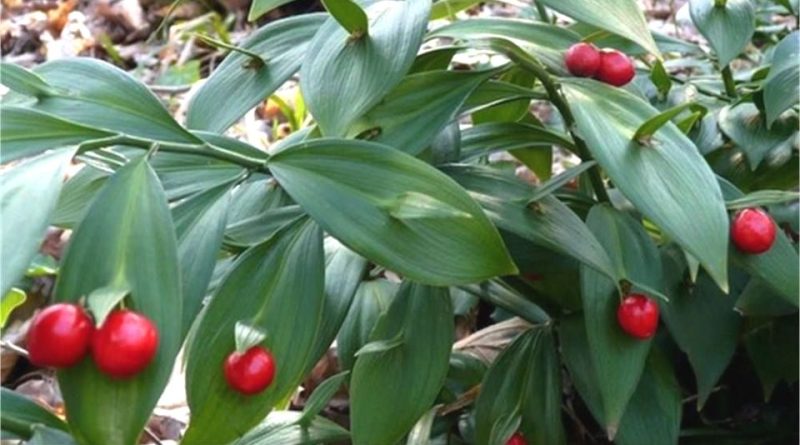Ruscus hypoglossum
Ruscus hypoglossum
The spineless butcher’s-broom, mouse thorn or horse tongue lily (Ruscus hypoglossum L., 1753) is an evergreen shrub species belonging to the Asparagaceae family.
Systematics –
From a systematic point of view it belongs to:
Eukaryota Domain,
Kingdom Plantae,
Magnoliophyta Division,
Liliopsida class,
Subclass Liliidae,
Order Liliales,
Liliaceae family,
Genus Ruscus,
R. hypoglossum species.
The terms are synonymous:
– Platyruscus hypoglossum (L.) A.P.Khokhr. & V.N.Tikhom.;
– Ruscus alexandrinus Garsault;
– Ruscus alexandrinus infrasubsp. Oppr;
– Ruscus humilis Salisb.;
– Ruscus hypoglossum var. laticladodia Yalt.;
– Ruscus hypophyllum var. hypoglossum (L.) Baker;
– Ruscus troadensis E.D.Clarke.
Etymology –
The term Ruscus comes from ruscum / ruscus, ancient Latin name of the butcher’s broom in Virgil and Pliny, assonant with rus Campagna.
The sepcific epithet hypoglossum comes from the Greek prefix ὑπο- hypo- below and from γλῶττα glotta / γλῶσσα gloss lingua: because the flower is under a tongue consisting of a small bract.
Geographic Distribution and Habitat –
Ruscus hypoglossum is a plant with a Mediterranean distribution, with extensions in the north to the area of the Vine, which extends from Spain to Macedonia, North Africa and Asia Minor up to the Caucasus. In Italy it is present in all regions except Sardinia, Puglia, Basilicata and Calabria.
Its habitat is that of the wild and shady areas of beech and deciduous broadleaf woods or where there is the olive tree from the plain up to 1400 m.
Description –
Ruscus hypoglossum is a small evergreen suffruticose shrub that reaches heights between 30 and 60 cm.
It has a creeping rhizome with slender, more or less compressed, simple stems.
Cladodes are elliptical of 3-4 x 8–9 cm or oblanceolate of 3-4 x 15–17 cm.
The leaves are reduced to strictly lanceolate scales of 3-4 x 9-12 mm.
The flowers are unisexual, in bundles of 3-6 in the center of the cladodes, with an axillary scale. The tepals are greenish in color.
The anthesis takes place in the winter months, from December to April, when a flower appears in the center of the cladode.
The fruit is a spherical berry, green at first which turns red when ripe; they have a diameter of 10-15 mm, with inside 1- 2 subspherical seeds, smooth, brown, of 5-8 mm of diameter.
This species is easily distinguished from Ruscus aculeatus L. which has much smaller cladodes (not exceeding 4 cm in length), with a pungent apex.
Cultivation –
spineless butcher’s-broom is a plant that grows spontaneously in the undergrowth of beech woods and deciduous broadleaf woods, sometimes also in humid holm oak woods, in central-northern Italy, in Campania and in Sicily (in Sardinia only as an adventitious), but which is often cultivated for ornamental purposes in parks and gardens to create borders.
It is an easy to grow plant that can be used for borders and for the food collection of cladodes.
Like Ruscus aculeatus it can be grown on many soil types and prefers a shady location, tolerating thick shade.
It is not very fond of soil moisture at the root level and is a plant resistant to prolonged drought.
This dormant plant withstands temperatures down to around -25 ° C.
Propagation can take place by seed which must be sown in spring. Germination is faster if the seed receives a cold stratification period. Germination can be quite slow, sometimes taking 12 months or more.
It can propagate faster by division in early spring. Larger divisions can be planted directly in their permanent locations.
Customs and Traditions –
Ruscus hypoglossum is a plant that is mainly used as an ornamental and for the use of its cladodes but which is also used in the medicinal field.
This plant, outside its range, has been grown in British gardens since the 16th century and was introduced to the United States in 1926 by the Burea of Plant Industry (USDA).
For food use, the young cooked shoots are used; these are harvested in spring as they grow in the ground and are used as a substitute for asparagus. They have a pungent and rather bitter taste.
The roasted seed is a substitute for coffee.
This plant, from a medicinal point of view, is little used in modern herbal medicine but, in consideration of its positive effect on varicose veins and hemorrhoids, it could find some use.
The root is aperient, obstructive, purifying, diaphoretic, diuretic and vasoconstrictor.
The plant contains saponin glycosides, including ruscogenin and neoruscogenin. These substances are anti-inflammatory and cause blood vessels, particularly veins, to contract.
Preparation Method –
The young shoots of Ruscus hypoglossum are collected in spring and used as soon as they have been blanched in various ways and, in general, like asparagus.
They are used in soups, omelettes, risottos and other typical preparations of the places where it also grows spontaneously.
The decoction of this plant was used, especially in the past, as a diuretic.
Guido Bissanti
Sources
– Acta Plantarum – Flora of the Italian Regions.
– Wikipedia, the free encyclopedia.
– Useful Tropical Plants Database.
– Conti F., Abbate G., Alessandrini A., Blasi C. (ed.), 2005. An annotated checklist of the Italian vascular flora, Palombi Editore.
– Pignatti S., 1982. Flora of Italy, Edagricole, Bologna.
– Treben M., 2000. Health from the Lord’s Pharmacy, Advice and experiences with medicinal herbs, Ennsthaler Editore.
Warning: Pharmaceutical applications and alimurgical uses are indicated for informational purposes only, they do not represent in any way a medical prescription; therefore no responsibility is taken for their use for curative, aesthetic or food purposes.


